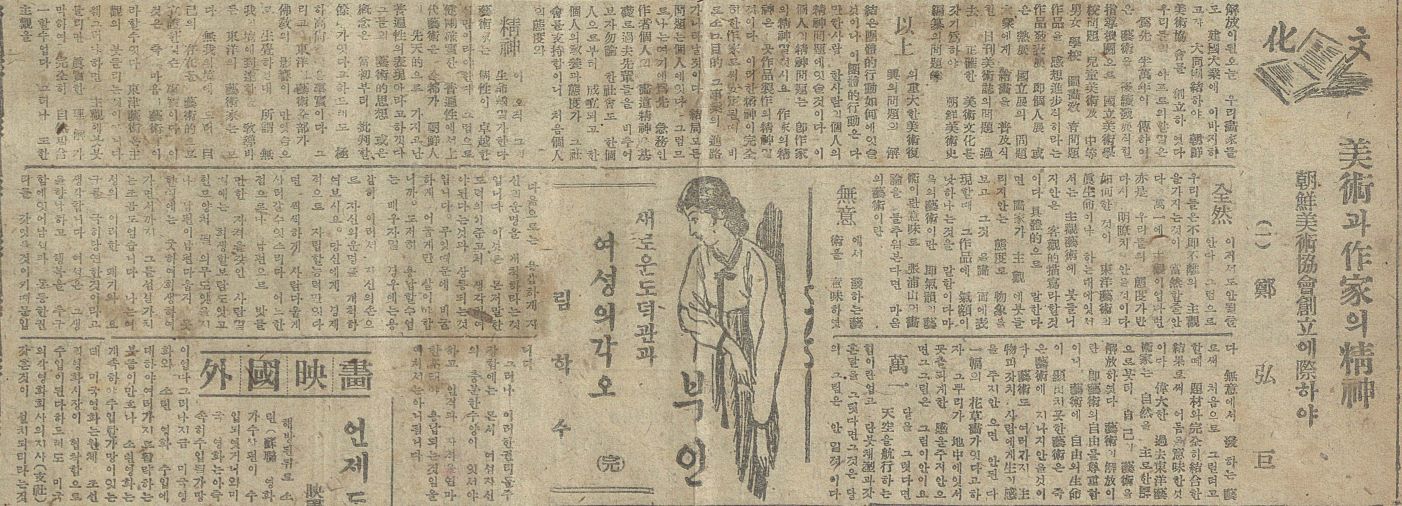
“Culture, Art, and the Spirit of the Artist—On the Establishment of the Korean Art Association,” Jungang sunmun, November 30, 1945, 2, column 11
Korean Art Association
* Source: Multilingual Glossary of Korean Art by Korea Arts Management Service
Related
-
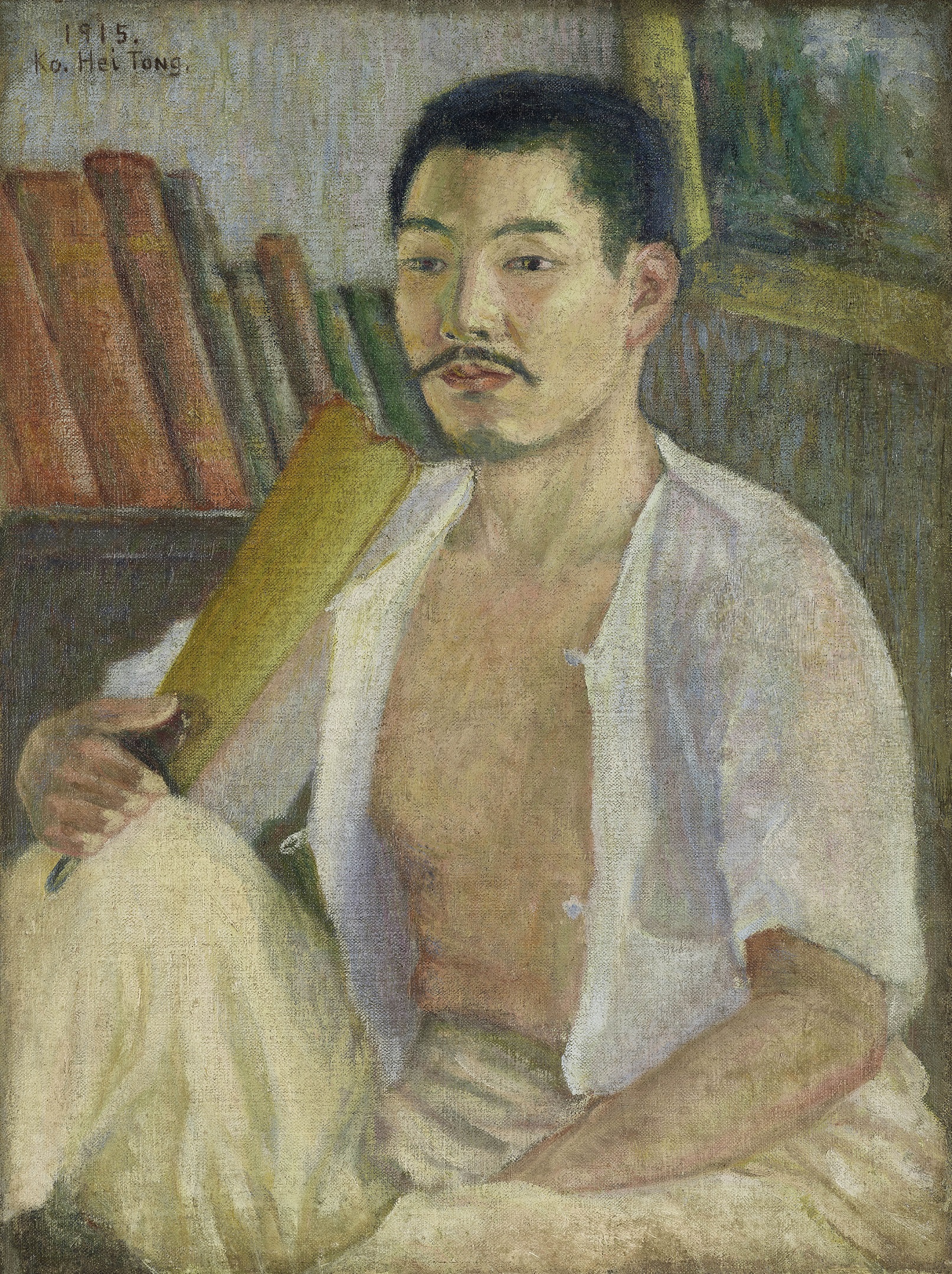
Ko Huidong
Ko Huidong (1886-1965, pen name Chungok) was born in Seoul and graduated from Hanseong French Language School. He worked as an interpreter and was appointed as a government official of the Korean empire. In 1907, he began to learn painting from An Jungsik and Cho Seokjin. He visited Japan to study art in 1909 and later attended Tokyo School of Fine Arts where he studied oil painting. The advent of Japanese colonization in 1910 caused him to lose his position as a government official and he became a student. He graduated in 1915. A Self-portrait with Jungjakwan (traditional Korean hat for government officials) reflected his self-consciousness of his former role as a government official of the Korean empire. His oil paintings, such as A Self-portrait with Durumagi (traditional Korean overcoat) or A Self-portrait Holding a Fan, are currently owned by the MMCA in Gwacheon. In the 1920s, he stopped creating Western paintings due to the lack of understanding of people around him. After this period, he focused on Eastern paintings depicting subjects such as Geumgangsan Mountain or other nativist landscape themes. He organized the Calligraphy and Painting Association [Seohwa hyeophoe] with An Jungsik, Cho Seokjin, and Lee Doyoung and worked as a secretary of that Association's exhibitions. He was acquainted with numerous other artists and he actively participated in political activism in the modern painter’s circle in Korea. Following the example of his father Ko Yeongcheol, a member of Yukgyo Poetic Gathering [Yukgyo sisa], he also interacted with other artists, such as Oh Sechang. He helped to organise artists as a chair of the Great Korean Art Association [Daehan misul hyeophoe] and later was appointed as a senator. In 1954, He was selected as the first chairman of the National Academy of Arts. His universal significance can be seen in his crucial contribution to the establishment of the first association of Western painting artists and modern artists in Korea.
-

No Soohyun
No Soohyeon (1899-1979, pen name Shimsan) learned painting from An Jungsik and Cho Seokjin at the Calligraphy and Painting Society (Seohwa misulhoe) and graduated in 1918. In 1920, he participated in a series of decorative paintings at Changdeokgung Palace, and the resulting mural of Joilseongwando is his work. In 1923, he co-founded the art group Dongyeonsa with Lee Yongwoo, Lee Sangbeom, and Byeon Gwansik. Even though this group attempted to explore new, non-traditional possibilities for Eastern painting, their association did not last long. During the 1920s, he participated in the Joseon Art Exhibition [Joseon misul jeollamhoe] and was the first artist to contribute editorial cartoons to the Choson Ilbo from 1924 to 1927. In the 1930s, he stopped participating in the Joseon Art Exhibition. Instead, he dedicated himself to exploring landscape painting based on his real experience of scenery and later established a new landscape painting style that incorporated the motif of oddly formed rocks and strangely shaped stones. Mountain Village (1956), Gyesanjeongchwi (Atmosphere of Valley and Mountain) (1957), Hongyeam (1961), and Paradise (1968) are considered his most representative works. He served as a judge and editorial board member of the National Art Exhibition and educated a variety of contemporary Eastern-style painters as an art professor at Seoul National University.
-
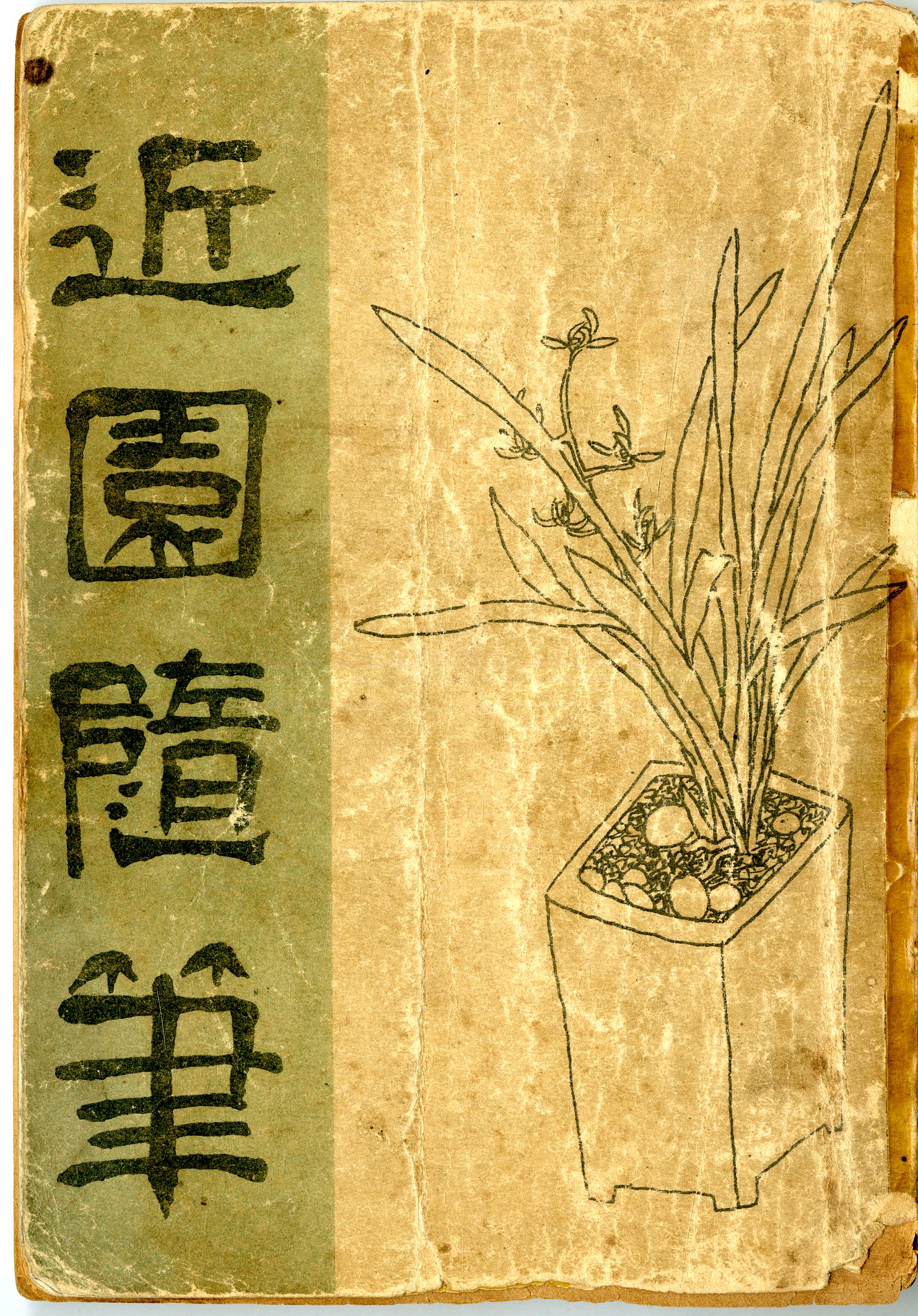
Kim Yongjun
Kim Yongjun (1904-1967, pen name Geunwon) was born in Daegu and first showed his promise as an artist when he was selected for the Joseon Art Exhibition [Joseon misul jeollamhoe] as a high school student. He published art criticism, such as On Reconstruction of Art Circle in Korea and Criticism on Proletarian Art, which demonstrated his potential as an art theorist. He also organized diverse art events, such as Dongmihoe and Baekjman Western Painting Association [Baekmanyanghwahoe] in the 1930s. During his later years, he was more active as an art critic and contributed essays to many newspapers and magazines rather than focusing on creating his own artwork. He participated in creating a magazine, Munjang, in 1939 and published a variety of essays on Eastern painting. After Independence, he contributed to the foundation of the fine arts division at Seoul National University and served as a professor at the Oriental painting department teaching Art History and Theory. He resigned his appointment and moved to Dongkook University because of his involvement in protesting the nationalization of Gyeongseong Imperial University (later Seoul National University). He worked as a dean of the Fine Arts College of Seoul National University for a few months after the outbreak of the Korean War in 1950 but moved to North Korea with his family during the 1950 September 28th restoration of Seoul by US and South Korean forces. He produced several Eastern paintings and published a wide range of art history essays in North Korea. Prior to his migration to North Korea, he wrote a few books such as Geunwonsupil (Essays of Kim Yongjun) (1948) and Joseon misul daeyo (A compendium of Korean art) (1949).
Find More
-
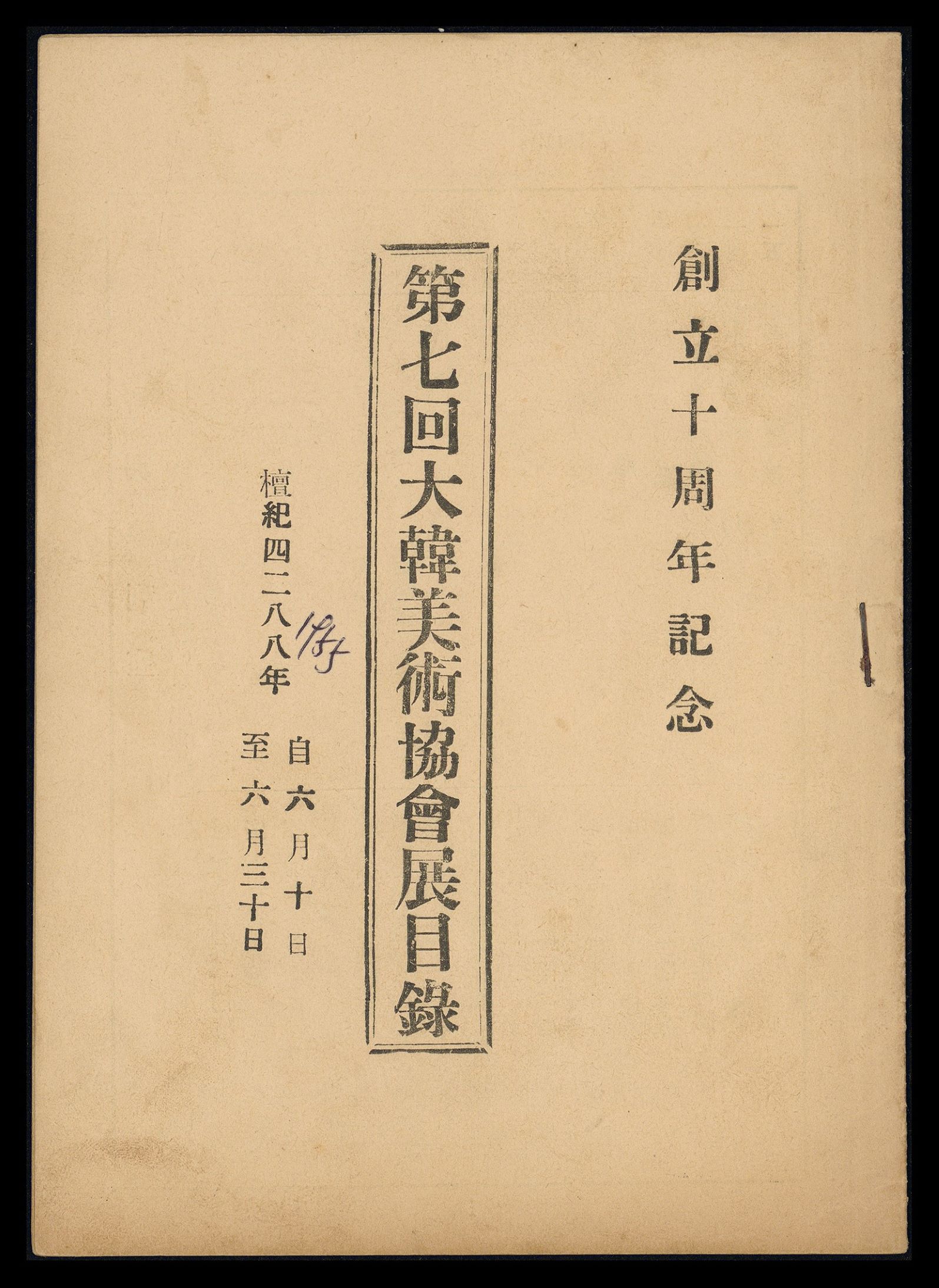
Great Korean Art Association
An art association that formed in 1948, when the Korean Art Association [Joseon misul hyeophoe], which was established in 1945, reformed in parallel with the establishment of the new Korean government. Following independence, the organization reformed and expanded primarily to foster solidarity and anti-communist sentiment in artists, and held the inaugural Great Korean Art Association Exhibition. In June 1961, the association closed officially with the government's comprehensive art institute reformation policy, and in December that year, the association merged into the Korean Fine Arts Association [Hanguk misul hyeopoe].
-

Korean Art Alliance
An organization created in 1946 in North Korea. as the result of a merger between the socialist Korean Artist Federation (Joseon misulga dongmaeng), the politically moderate Korean Plastic Arts Federation (Joseon johyeong yesul dongmaeng), the Joseon Sculpture Association, and former members of the Korean Art Association (Joseon misul hyeophoe). Together, these associations collaborated to host an Independence Cultural Art Exhibition and founded the Korean Art Alliance (Joseon misul dongmaeng). The Alliance actively conducted enlightenment activities under the doctrine of “Art for Public Awareness” and leftist artists were the primary members. The leadership of the Alliance was comprised of Yoon Hee-soon, Lee Insung, Oh Chiho, and Gil Jinseop. The Alliance’s doctrines included the implementation of democracy, departure from the influences of imperialism, establishment of National Art, and the enlightenment of the populace. The Alliance engaged in raising public awareness about modern art through activities such as street exhibitions, touring exhibitions, and the production of posters and leaflets. The Korean Art Alliance (Joseon misul dongmaeng) was an influential faction within the art community of the 1940s, raising public awareness about art and issuing statements on political events before disbanding in 1948.
-
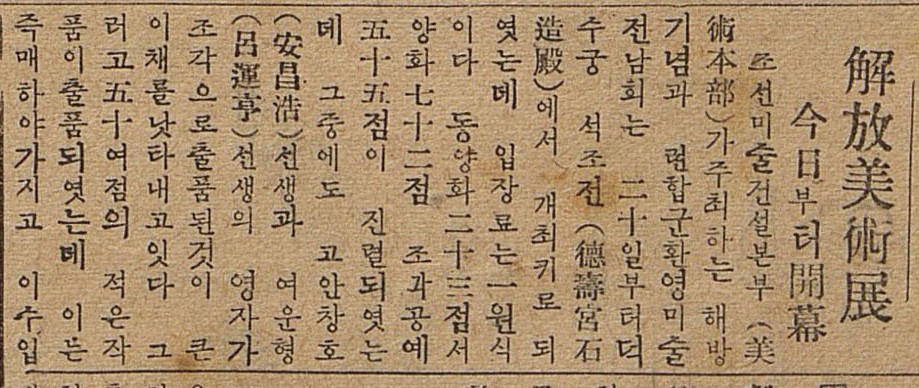
Korean Art Construction Headquarters
An artist organization established in August 18, 1945 and dissolved November 20, 1945. The founding of the organization was led by Kim Jukyung, Jeong Hyeonung, Gil Jinseop, and Yoon Hee-soon. The organization was one of the five divisions of the Central Committee for the Construction of Korean Culture [Joseon munhwa geonseol jungang hyeobuihoe] which included literature, art, music, film, and theater. The goal of the headquarters was the “new and unified building of Korean art,” and Ko Huidong was designated as the head commissioner. The Headquarters was the largest art organization after independence, comprising a total of 186 artists in six different divisions; Eastern Art, Western Art, Sculpture, Crafts, Children’s Art, and advertisement art. The first activities of the Korean Art Construction Headquarters [Joseon misul geonseol bonbu] after its establishment included the creation of banners, portraits, and national flags for the welcoming parade to celebrate the arrival of Allied Forces. From October 20th to 29th, 1945, the headquarters held the first Art Exhibition for the Celebration of Independence and the Welcoming of the Allied Forces. The exhibition featured 23 works of Eastern-style art, 72 works of Western-style art, and 55 works of sculpture and crafts produced by about 90 artists. After the dissolution of the Headquarters, right-wing members including Ko Huidong established the Korean Art Association [Joseon misul hyeophoe] in 1945.






